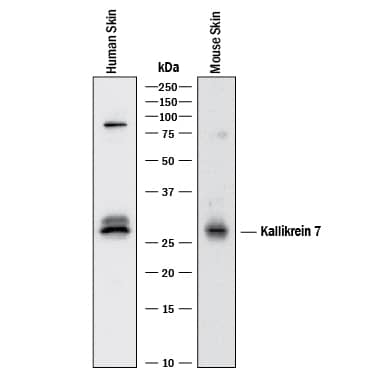Human/Mouse Kallikrein 7 Antibody
R&D Systems, part of Bio-Techne | Catalog # AF2624


Key Product Details
Species Reactivity
Validated:
Human, Mouse
Cited:
Human, Mouse
Applications
Validated:
Immunohistochemistry, Immunoprecipitation, Western Blot
Cited:
Immunohistochemistry, Immunohistochemistry-Frozen, Immunohistochemistry-Paraffin, Western Blot
Label
Unconjugated
Antibody Source
Polyclonal Goat IgG
Product Specifications
Immunogen
Mouse myeloma cell line NS0-derived recombinant human Kallikrein 7
Glu23-His252
Accession # P49862
Glu23-His252
Accession # P49862
Specificity
Detects human and mouse Kallikrein 7 in direct ELISAs and Western blots.
Clonality
Polyclonal
Host
Goat
Isotype
IgG
Scientific Data Images for Human/Mouse Kallikrein 7 Antibody
Detection of Human and Mouse Kallikrein 7 by Western Blot.
Western blot shows lysates of human skin tissue and mouse skin tissue. PVDF membrane was probed with 1 µg/mL of Goat Anti-Human Kallikrein 7 Antigen Affinity-purified Polyclonal Antibody (Catalog # AF2624) followed by HRP-conjugated Anti-Goat IgG Secondary Antibody (Catalog # HAF017). A specific band was detected for Kallikrein 7 at approximately 27-30 kDa (as indicated). This experiment was conducted under reducing conditions and using Immunoblot Buffer Group 1.Kallikrein 7 in Human Skin.
Kallikrein 7 was detected in immersion fixed paraffin-embedded sections of human skin using 1.7 µg/mL Goat Anti-Human Kallikrein 7 Antigen Affinity-purified Polyclonal Antibody (Catalog # AF2624) overnight at 4 °C. Tissue was stained with the Anti-Goat HRP-DAB Cell & Tissue Staining Kit (brown; Catalog # CTS008) and counterstained with hematoxylin (blue). View our protocol for Chromogenic IHC Staining of Paraffin-embedded Tissue Sections.Applications for Human/Mouse Kallikrein 7 Antibody
Application
Recommended Usage
Immunohistochemistry
5-15 µg/mL
Sample: Immersion fixed paraffin-embedded sections of human skin
Sample: Immersion fixed paraffin-embedded sections of human skin
Immunoprecipitation
25 µg/mL
Sample: Conditioned cell culture medium spiked with Recombinant Human Kallikrein 7 (Catalog # 2624-SE), see our available Western blot detection antibodies
Sample: Conditioned cell culture medium spiked with Recombinant Human Kallikrein 7 (Catalog # 2624-SE), see our available Western blot detection antibodies
Western Blot
1 µg/mL
Sample: Human skin tissue and mouse skin tissue
Sample: Human skin tissue and mouse skin tissue
Reviewed Applications
Read 1 review rated 5 using AF2624 in the following applications:
Formulation, Preparation, and Storage
Purification
Antigen Affinity-purified
Reconstitution
Reconstitute at 0.2 mg/mL in sterile PBS. For liquid material, refer to CoA for concentration.
Formulation
Lyophilized from a 0.2 μm filtered solution in PBS with Trehalose. *Small pack size (SP) is supplied either lyophilized or as a 0.2 µm filtered solution in PBS.
Shipping
Lyophilized product is shipped at ambient temperature. Liquid small pack size (-SP) is shipped with polar packs. Upon receipt, store immediately at the temperature recommended below.
Stability & Storage
Use a manual defrost freezer and avoid repeated freeze-thaw cycles.
- 12 months from date of receipt, -20 to -70 °C as supplied.
- 1 month, 2 to 8 °C under sterile conditions after reconstitution.
- 6 months, -20 to -70 °C under sterile conditions after reconstitution.
Background: Kallikrein 7
References
- Hansson, L. et al. (1994) J. Bio. Chem. 269:19420.
- Caubet, C. et al. (2004) J. Invest. Dermatol. 122:1235.
- Ekholm, E. and T. Egelrud (1999) Arch. Dermatol. Res. 291:195.
- Hansson, L. et al. (2002) J. Invest. Dermatol. 118:444.
- Brattsand, M. et al. (2004) J. Invest. Dermatol. 124:198.
Alternate Names
KLK7
Gene Symbol
KLK7
UniProt
Additional Kallikrein 7 Products
Product Documents for Human/Mouse Kallikrein 7 Antibody
Product Specific Notices for Human/Mouse Kallikrein 7 Antibody
For research use only
